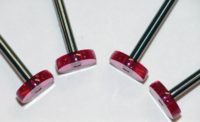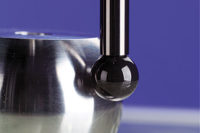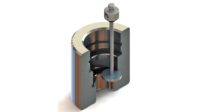Browse through any coordinate measuring machine (CMM) or machine tool stylus catalog, and you’ll see an array of available materials from which to choose. Of course, the old standbys—ruby balls, carbide shafts, and stainless steel bases—are still there. But today you’ll find silicon nitride, zirconia, steel, diamond, carbon fiber, ceramic, titanium and more. This leads to lots of questions about the best material for the job. In this article, we’ll explore materials and their advantages and disadvantages.
TECH TIPSIn response to evolving markets, CMM and machine tool styli are becoming lighter, stiffer, and more wear resistant. Today, a plethora of material choices exists when choosing styli for a CMM or machine tool probe. If you are unsure of the best choice for your particular application, contact the stylus manufacturer for advice. |
The first CMMs used a manually positioned stylus made from hardened steel. Back then, stylus designs were limited to a steel ball brazed onto a steel stem, half a steel cylinder, and a steel cone designed to be pressed into a hole so as to locate its center point quickly. The operator would hold the stylus on a surface, against an edge, or press it into a hole, and then step on a foot switch to record its position.
Probe systems quickly improved, and so did styli. Early touch-trigger probes used a ball stylus similar to those used today. The balls were steel and the shafts were unthreaded. Instead of threads, a set screw held the shaft in place. Today’s familiar three-piece stylus consisting of a ball, a stem, and a threaded base appeared in the 1980s with the proliferation of touch-trigger probe heads on CMMs and machine tools.
Ruby is still the ball material of choice for most CMM and machine tool applications. Ruby balls are relatively inexpensive and wear-resistant. Tungsten carbide, thanks to its inherent stiffness, is most often used for stylus shafts, or stems. Stainless steel is the most common material for threaded bases.
So what’s with all the new materials?
As measuring and probing systems have evolved, so have their stylus requirements. Many of today’s probing systems put limits on stylus length and weight. These limits create a need for weight-saving materials that still provide sufficient rigidity. Certain CMMs are designed to work on the factory floor. These require tooling resistant to temperature fluctuations. Hand-operated CMM “arms” are common in today’s manufacturing and inspection areas. These hand-operated CMMs need rugged styli built from materials that can withstand manual use.
Machine tool styli, on the other hand, incorporate a so-called “mechanical fuse.” Most machine tool styli are designed to break in the event of a collision, to avoid damage to the machine or probe head.
As medical and electronic parts shrink in size, so do styli. Not long ago, styli with balls smaller than 1.5 mm were considered exotic. They were deemed fragile and difficult to calibrate. Today they are commonplace. Styli with 0.2 mm (0.008”) diameter balls were recently introduced to serve this expanding field. To put that into perspective, a 0.2 mm ball is smaller than the period at the end of this sentence.
These changes have induced the introduction of new materials to satisfy these evolving requirements. Here’s an overview of the materials that comprise the major components of a stylus: 1) the ball, 2) the stem and 3) the threaded base.
THE BALL
Balls made from synthetic ruby are the industry standard. Ruby is second only to diamond in hardness and thus exhibits superior wear resistance. Ruby has a relatively low coefficient of friction, making it a good choice for applications involving continuous contact probing, or “scanning.” However, when scanning untreated aluminum, aluminum tends to build up on the surface of the ball, rendering it unsuitable for further use. In addition, abrasive surfaces can wear a flat spot on a ruby ball. For these applications, we recommend silicon nitride balls.
Silicon nitride is a very hard industrial ceramic used primarily for ball bearings. In addition to their spherical precision, silicon nitride balls are highly polished. The downside is that they are difficult to machine, making them more expensive than ruby balls for use in styli. Silicon nitride ball styli are well suited for production applications involving repetitive probing, especially with untreated aluminum. They also work very well on abrasive surfaces, like those produced by erosive machining (EDM). In most applications, silicon nitride balls will outlast ruby balls. They are a good choice for just about any material, except cast iron.
Zirconia is the ball material of choice when probing cast iron. Zirconia is a hard, highly polished ceramic. Zirconia’s mechanical properties make it better suited than ruby and silicon nitride for use on cast iron.
Sometimes a stylus must be electrically conductive. In this case, a carbide or hardened steel ball is needed. Steel balls are often available in a greater range of diameters than carbide balls, and usually cost less. Therefore, hardened steel balls are often the best choice when the entire stylus must conduct an electrical current.
Ceramic (alumina) balls are popular in ball diameters above eight millimeters. Ceramic is lighter than steel or carbide. It’s highly polished, and resists wear. Ceramic balls with diameters larger than eight millimeters are less expensive than equivalent ruby balls. However, ceramic balls are often manufactured to a lower grade of sphericity than ruby balls. A typical 10 mm ceramic ball is ground to grade 25 sphericity while a typical ruby ball will be grade 10. But the ruby ball costs more. A tradeoff between price and precision arises with these large diameter balls.
Diamond balls appeared about ten years ago. Early offerings were limited in size, and the prices were breathtaking. Diamond is, of course, the hardest known substance. Much like ruby, laboratory-grown diamonds are used to create diamond balls. When used in a contact measurement device like a CMM, a diamond ball will not wear. Diamond ball sizes have increased a bit, but their prices are still high relative to ruby or silicon nitride.
THE STEM
Tungsten carbide is the most commonly used material for stylus stems. Carbide is relatively easy to machine and has excellent rigidity. It can be ground to very small diameters. It’s heavy, though, a property that often conflicts with high-performance probe systems sensitive to stylus weight. Nevertheless, carbide remains the material of choice for most styli manufactured today. When using balls between 0.2 mm and 1.5 mm diameter, carbide is the only option.
If stylus weight is a concern, we recommend carbon fiber. Carbon fiber is lightweight and rigid. It’s resistant to thermal fluctuations, a desirable property on the shop floor. Carbon fiber is usually a good choice for very long styli. Carbon fiber’s downside, however, is the bending it exhibits in long, thin shafts. In these cases, we’ll often suggest a ceramic stem as an alternative to carbon fiber, to help keep the weight down and the rigidity up.
Ceramic stems are commonly used in machine tool probe systems. A ceramic stem helps ensure that, in the event of a collision, the stylus will break first, preventing damage to the probe head or the machine tool. Ceramic is light, stiff, and brittle. Styli with ceramic shafts longer than 150 mm are easily broken. Carbon fiber is the best option for a lightweight stem longer than 150 mm.
Stainless steel stems are easily manufactured but prone to deflection. Deflection, or bending, is usually unacceptable in precision measurement. Although stainless steel stems are machined from a single piece of steel, we don’t recommend them except when the stylus cost is more important than its performance.
Some customers need non-magnetic styli. They require a ceramic or carbon fiber shaft with a hard anodized aluminum threaded base. However, due to the aluminum base, thread sizes are limited.
THE THREADED BASE
Stainless steel is the most popular choice for threaded bases. It’s inexpensive and easy to machine, properties that help lower cost. But stainless steel is heavier than aluminum or titanium, rendering it undesirable for use on weight-sensitive probe systems.
The demand for titanium stylus bases is growing. Because titanium is more expensive and harder to machine than stainless steel, it increases the stylus price. Nevertheless, titanium is an excellent choice for a threaded base. It’s light, wear-resistant, and thermally stable.
Aluminum is lighter than titanium and stainless steel. It’s inexpensive and easily machined. But aluminum is soft and is most affected by thermal fluctuations. Because it’s so soft, aluminum bases are restricted to larger thread sizes. Aluminum is a good choice when stylus weight is an issue, and ambient temperature is relatively stable.
PUTTING IT ALL TOGETHER
In response to evolving markets, CMM and machine tool styli are becoming lighter, stiffer, and more wear resistant. Today, a plethora of material choices exists when choosing styli for a CMM or machine tool probe.
If you are unsure of the best choice for your particular application, contact the stylus manufacturer for advice. They know which materials work best, and which materials to avoid. Ask for a recommendation.
Finally, user feedback is very helpful to your manufacturer. If a particular stylus performs well, pass that information along to them. If you’re experiencing excessive wear or other issues with the stylus, let your manufacturer know about that, too.
Physical characteristics of materials are one thing. Real-life experiences can be quite another. Working together with you, your stylus manufacturer can help optimize your measurement processes. After all, there are a lot of choices now.






